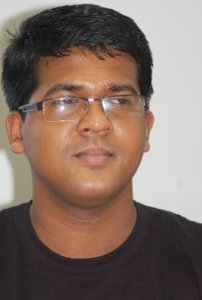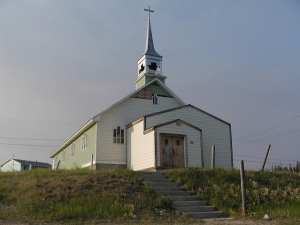


Days after he began what was originally expected to be a second three-year appointment as co-pastor of St. Lawrence Roman Catholic Church here in Thompson, Manitoba, Father Subhash Joseph, a missionary priest from India, said July 18 he is being transferred to the repair-challenged Church of St. Gertrude in Pelican Narrows, Saskatchewan, located 120 kilometres northwest of Flin Flon; 388 kilometres northeast of Prince Albert and 525 kilometres northeast of Saskatoon, and the Church of Our Lady of Seven Sorrows in Sandy Bay, at road’s end for the gravel winding road, 72 kilometres north of Pelican Narrows. The transfer, requested by Father Joseph, as he is known, and approved by Archbishop Murray Chatlain, archbishop of the Archdiocese of Keewatin-Le Pas, will probably take place in October. He will serve in Pelican Narrows and Sandy Bay by himself, replacing Father Susai Jesu, an Oblate, also from India.
Father Joseph, along with Father Guna Pothula, his co-pastor at St. Lawrence Church in Thompson, are both from India and members of the Congregation of the Missionaries of St. Francis de Sales, founded by Father Peter Marie Mermier from Vouray in the parish of Chaumont en Genevois and the Diocese of Annecy in the Savoy region of France in October 1838 for parish mission, foreign mission and youth education. They are also known as the Fransalians. Pope Pius XI proclaimed St. Francis de Sales in 1923 as the patron saint of writers and journalists. Francis de Sales was born in France and lived at the time of the Protestant Reformation, becoming Bishop of Geneva. He had lots of exposure to Calvinism and predestination and was noted for his diplomacy in the volatile, heated religious climate of the day in Switzerland. He’s honored as one of the doctors of the Catholic Church and the worldwide Anglican Communion.
The missionary order allows it priests to live abroad for up to 10 years. Father Joseph and Father Guna arrived in Thompson together three years ago in July 2012. Their requests to have their terms extended for a further three years were approved earlier this year by the provincial superior of their missionary order in India and the local archdiocese here. Father Guna, who will be staying on at St. Lawrence in Thompson, will now be joined in due course by another priest, likely from Andhra Pradesh in southeastern India where he is from, and also a member of the Congregation of the Missionaries of St. Francis de Sales.
In Cree, Pelican Narrows is called Opawikoscikcan, which means “The Narrows of Fear.” The community consists of the Northern Village of Pelican Narrows and Pelican Narrows 184B Indian Reserve, the administrative centre of the Peter Ballantyne Cree Nation. The combined population is about 2,700, with more than two-thirds of the population – about, 1,900 of the 2,700 residents – living on the reserve. Sandy Bay’s name in Cree is Wapaskokimawn, meaning “okimaw,” which is “boss” in Cree, or “non-native agent.” With a combined population of about 1,200, the community, like Pelican Narrows, is also split into two parts: the Northern Village of Sandy Bay and Wapaskokimaw Indian Reserve No. 202, with about one quarter of Sandy Bay’s combined population being members of the Peter Ballantyne Cree Nation.
Major businesses and industry in Pelican Narrows consist of the Co-op Fisheries and Fish Plant, The Northern Store, Mum’s Restaurant, Charles Confectionery, PBCN Band Store, Pearson Enterprises, Nikatosik Forestry and Pelican Narrows Air Services.
In 1876, Father Étienne Bonnald, a member of the Oblates of Mary Immaculate (O.M.I.), often known simply as Oblates, and also a missionary order, sought to establish a Catholic presence within the Village of Pelican Narrows, which had started out as a Protestant community. St. Gertrude was erected two years later in 1878.
The Church of St. Gertrude in Pelican Narrows, where 90 per cent of the parishioners are Cree, had fallen into such a state of disrepair in recent years, Catholic Missions In Canada identified it as a mission church it was going to help fund repairs for. St. Joseph’s Catholic Parish Social Justice Committee in Moose Jaw, at the suggestion of Catholic Missions In Canada, began helping with repairs through its “St. Gertrude’s Project” in 2010. You can watch a short YouTube video on the project here at: https://www.youtube.com/watch?v=IeLwJCejEJQ
Les Oblats de Marie Immaculée, or The Missionary Oblates of Mary Immaculate (O.M.I.), established the first mission at Ile-À-la-Crosse, Saskatchewan in 1860.
Another Oblate priest, Father Ovide Charlebois, arrived as pastor of St. Gertrude in 1900. While in Pelican Narrows, he constructed a new church with a bell, and a statue of Our Lady of Lourdes was erected. Ten years later, on March 4, 1910 when the Vicariate Apostolic of Keewatin, forerunner to today’s Metropolitan Archdiocese of Keewatin Le Pas, was created from territory of the Diocese of Prince Albert, and Charlebois, elevated to bishop, was appointed as its first ordinary on Aug. 8, 1910 and installed as vicar apostolic on March 7, 1911.
The Archdiocese of Keewatin-Le Pas takes in some 430,000 square kilometres and stretches across the northern parts of three provinces – Saskatchewan, Manitoba and a small portion of Northwestern Ontario.
The farthest point west is La Loche, Saskatchewan., near the Alberta border. The farthest point north is Lac Brochet here in Manitoba. The distance from Our Lady of the Sacred Heart Cathedral in The Pas, which serves as the archdiocesan seat, to La Loche by car, is 850 kilometres – an 8 1/2 -hour drive – and the archbishop, as shepherd of the flock, has to travel through the Diocese of Prince Albert in Saskatchewan to reach La Loche in his own archdiocese on travelling pastoral visits.
The farthest point east travelled is Sandy Lake, Ont., a fly-in and Northern Ontario Winter Road Network-only remote Oji-Cree First Nations community in Northwestern Ontario, 450 kilometres northeast of Winnipeg and 600 kilometres northwest of Thunder Bay.
The distance from The Pas to Sandy Lake is a combined six-hour drive to Winnipeg, followed by a one-hour plane ride.
Lac Brochet is reached by a four-hour drive from The Pas to Thompson and then an hour flight from Thompson to Lac Brochet. En route to Lac Brochet, the archbishop sometimes stays at the rectory at St. Lawrence Church on Cree Road in Thompson overnight waiting to catch a flight.
The Congregation of the Missionaries of St. Francis de Sales has long had a presence in India, dating back to 1846. The Visakhapatnam Province of the Congregation of the Missionaries of St. Francis de Sales in India also has missions in Trinidad and Papua New Guinea, as well as the Archdiocese of Keewatin-Le Pas here in Canada.
Father Joseph joined the seminary at the age of 16 in 1998 and was ordained a priest in 2010. He is from Therthally in Kerala on the Malabar Coast in southwestern India, which dates back some 20 centuries to the Christians of St. Thomas, named for Saint Thomas the Apostle, also known as “Doubting Thomas,” who is believed in apocryphal literature to have arrived in India around 52AD, seeking converts to Christianity. He was martyred, it is believed, about 20 year later in 72AD, near Mylapore, India, lanced by a spear as he prayed kneeling on a stone.
You can also follow me on Twitter at: https://twitter.com/jwbarker22
55.737522
-97.862909

 Father Laurent Alarie, a member of the Missionary Oblates of Mary Immaculate (OMI), commonly known as simply the Oblates or OMI, and the longest-serving pastor in the history of St. Lawrence Roman Catholic Church in Thompson, Manitoba, died in Winnipeg March 16 at the age of 98.
Father Laurent Alarie, a member of the Missionary Oblates of Mary Immaculate (OMI), commonly known as simply the Oblates or OMI, and the longest-serving pastor in the history of St. Lawrence Roman Catholic Church in Thompson, Manitoba, died in Winnipeg March 16 at the age of 98.

